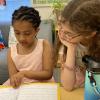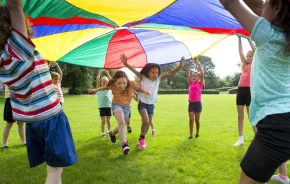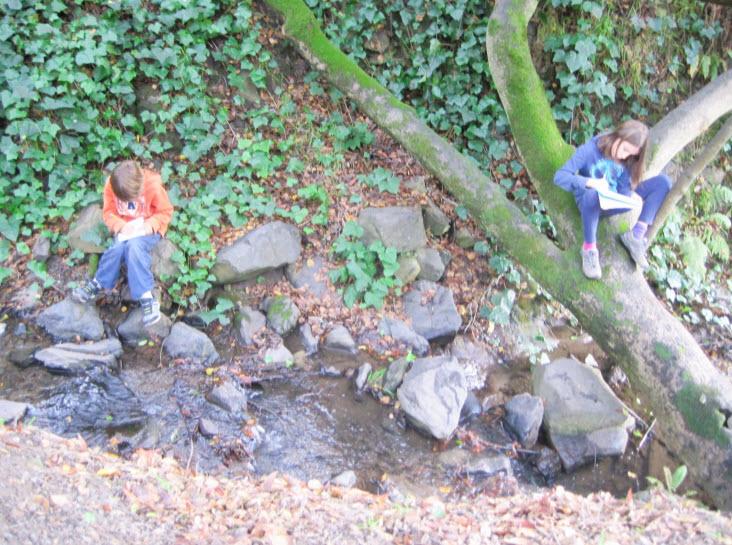 Six kids follow me into the woods, ages five to nine. We do not speak as we gaze up at the tall redwoods, lean towards the murmur of the creek, sniff the ferns, and slide fingers over smooth rocks.
Six kids follow me into the woods, ages five to nine. We do not speak as we gaze up at the tall redwoods, lean towards the murmur of the creek, sniff the ferns, and slide fingers over smooth rocks.
We spread out and sit in our own place in the woods: perched on a step made of stone, leaning back against a wide tree, curled over a rock by the water, silently observing.
It is time to write a poem. We open our journals, pull out pencils, and write.
When the time is up, we gather near the creek to share our poems. “Who wants to start?” I ask. At first, no one volunteers, but then a boy with a little voice stands with legs crossed, journal in front of his face, and reads:
O waterfall
how do you make that sound?
splitter splat, splitter splat,
you feel like cold icy water
going down my throat
- Milo, Age 6
We snap our fingers in appreciation. The youngest child peeks out from his baseball cap, takes a deep breath and says, “I’ll go next.”
We are on a poetry walk, a family tradition these last four summers, a favorite activity with my third-grade students – I was an elementary schoolteacher for 16 years – and an incredibly simple way to kick start poetry with writers of all ages and turn on reluctant writers. It is also a wonderful way to engage with a place, whether you are walking deep in the forest or swinging through the urban jungle. We are doing a little bit of both: wandering the pathways of a botanical garden in Berkeley, California.
Why a poetry walk?
Inspired by Natalie Goldberg’s “Writing Marathon,” a poetry walk is when a small group walks, sits and writes in several locations, sharing their work each time and moving on again and again. The key is the "again," observing, writing, sharing, observing, writing, sharing, always with a supportive audience, taking a stab at a poem, hearing what others come up with and getting lots of chances.
The idea is that very quickly, a momentum builds, trips a switch and you enter a kind of Zen state of awareness, where your anxiety falls away and everything you see, hear, smell, taste and touch becomes material for your next creation.
Of course, it is never quite that simple. You can’t just hand a kid a journal and a pencil, sit them on a bench and expect magic, although that might be enough for some. The successful poetry walk is built upon the first gathering of the group.
Starting the walk
The children sit on a large, flat rock at the entrance of the Berkeley Botanical Gardens. They clutch journals and pencils and their minds are filled with swirling notions of what poetry is, from red roses to haiku. I want them to forget all that, today, and just see poetry as writing without rules, completely free and from the heart.
Behind me they see tall cacti, a redwood grove and paths leading off to the gardens. “We are about to take a poetry walk,” I begin. “We will walk, choose a spot to sit, and write about anything we want. Then we will share and move on to a new spot. As you walk, look around you very carefully and search for something to write about. Listen to the language of the bugs, the song of the birds. Smell the flowers. Touch the bark of a tree or smooth surface of a rock.”
“Most of all, look for one thing to write about. You may just write, “Bamboo. Tall. Thin. Moving in the breeze.” Or you may write, “The bamboo is having a dance party. The music is the wind whipping up the canyon: boom, boom, boom.”
This is a great moment to have one of the kids stand and read a poem, ideally from a previous poetry walk.
hidden in the foliage beneath huge leaves
comes the creek
swish swish gurgle
gurgling off ledges
over colored rocks
through dead leaves
and upstream,
hidden in the shadowy trees
comes a mini waterfall splashing down
crash crash
the bubbly, twisty, falling creek
has a life
of its own
- Mila, Age 9
I stop and look at them to see how we are doing. Several kids are smiling, eyes gleaming, ready to roll. The small boy with the baseball cap looks worried. He creates beauty by snagging a baseball from the blue sky, or striking a soccer ball with his left foot and sending it curving into the corner of the goal, but he is newer to this poetry business.
“Final rules,” I tell them before we head to our first location. “Pay attention, don’t talk, and have fun!”
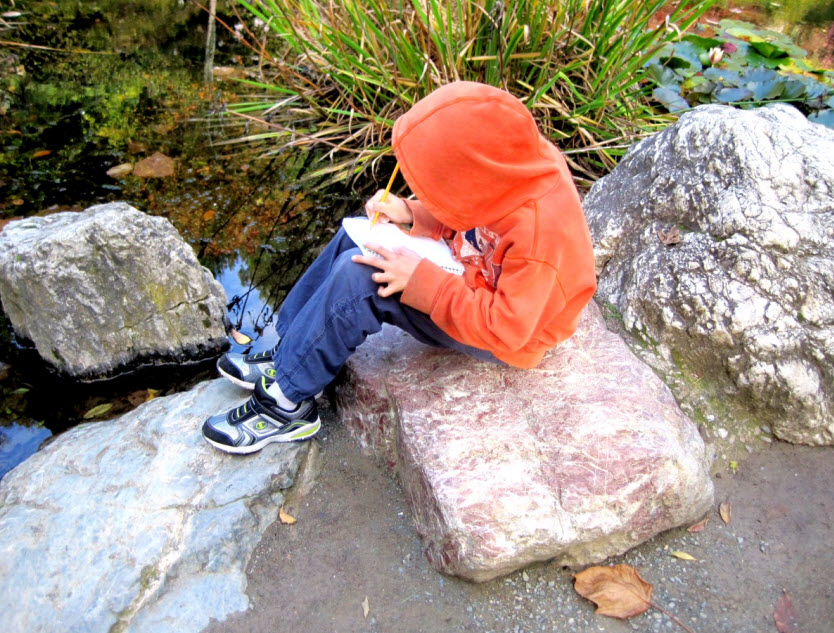 First poems
First poems
I have chosen our first spot on a hillside above the woods. I tell the kids not to expect great writing the first time. As Natalie Goldberg says, “You are free to write the worst junk in America.”
We spread out just enough to get some privacy, but not so far that I can’t quickly call them back to share their work. I set an arbitrary time limit: “Write for seven minutes! No talking! Write anything that comes in your head. Keep writing the whole time. If you finish one poem, start another! Ready, set, write!”
I used to spend more time, checking in on each kid, but now I know that eventually they will get there, if not by the second location then by the third. It is better if I just model what I expect right from the start. I sit where the boy with the baseball cap can see me. I open my journal, stare at a plant and just start writing. After some hesitation, he too begins writing, slowly, but writing. After five minutes I make the rounds, whispering, “Two more minutes until we share.”
We gather and I say, “Who wants to start? You can share a whole poem or just some of your best lines.” The older girls share first. Then the boy with the little voice. Suddenly, a seven-year-old boy with long hair and penchant for sword fighting with sticks stands and surprises me:
The lizard was being as still as he could
and he was almost engraved in the wood
but when we reached out a finger
he just scurried away
leaving nothing but dust
and a pile of hay
- Nicky, Age 7
He is met with enthusiastic snapping and wide-eyed appreciation. The boy with the baseball cap goes last, reading very carefully:
A little hole,
green around the silver sky
and a bee flying over the silver edge
a bee flying from edge to edge
and little birds
- Ronan, Age 5
Another wave of happy snaps. To finish the first round, I read my new poem. Nothing special, just perfectly imperfect and not rhyming.
Now I look around and see their faces loosening and their grips on pencils tightening. I love this moment after the first share. There is an almost palpable sense of “OK, now I get it. Let me at it!” We plunge off into the clump of redwood trees towards the splitter-splatter of the little waterfall in the creek. As we cross a bridge, the boy in the baseball cap says, “Stop!”
“I want to stop here,” he demands.
“But why?”
“I want to stop here and write,” he says. “I want to write a poem about this bridge!”
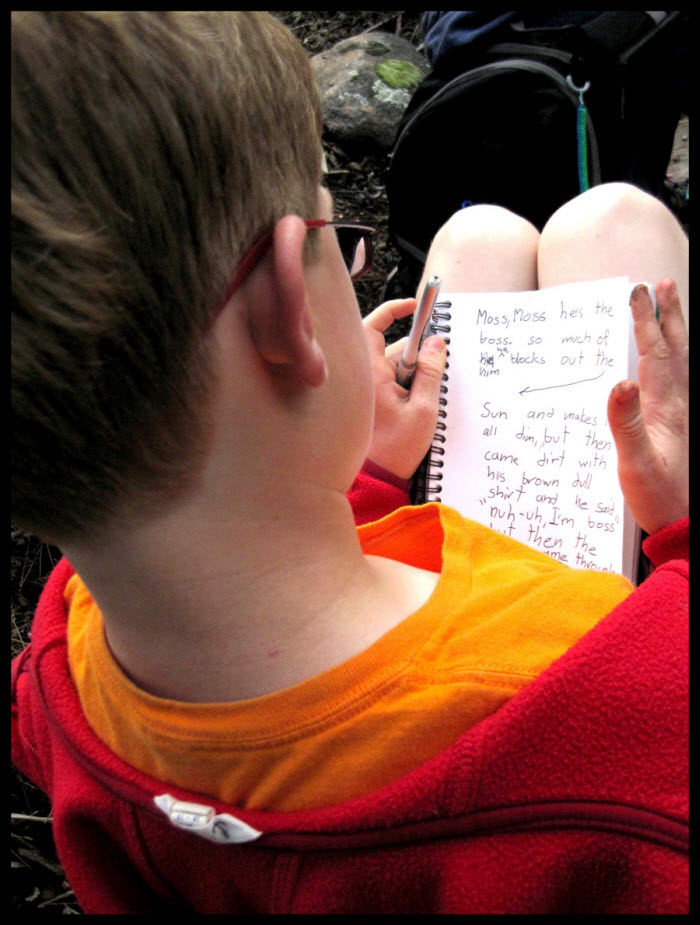 The closing ceremony
The closing ceremony
Two hours later, after we have written and shared from several locations, we find a scenic spot, a deck looking out over the creek, and bring the walk to a close by each sharing our best poem to wild applause.
Now there is no hesitation. Ever since the second round, in fact, the youngest kids have shared first. They have all surprised me with their ability to grasp poetry, to follow their ideas and let go of inhibitions. I listen with glee to a tall girl with a leprechaun’s smile read:
smooth stems wind up and up
as they cross paths
with the branches of tall trees
winding up into the sky
where an eagle flies
soaring over the tree-colored land
- Marnie, Age 8
Now, a girl with green eyes, my daughter, reads, saying it far better than I ever could:
I sit on the cool rocks
the creek’s gurgling
blocks the traffic noises
all is silent
it’s just the pencil, the paper and me
relax
cool down,
I hear the creek say...
this is happy
- Maya, Age 9
More resources on poetry walks and writing with kids
The National Writing Project -- improving writing in our nation's schools
About the author: Evan Nichols has been an elementary school teacher in the public schools for the past sixteen years. He is a Teacher Consultant with the Bay Area Writing Project and the editor of Digital Paper, a literary eZine for Bay Area teachers. He lives in Oakland, California, with his wife and two children. He just earned an MFA in Creative Writing at Mills College.





